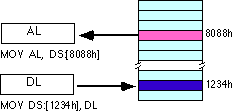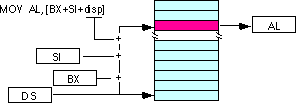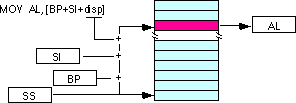
mov (move) instruction:
mov destination, source
This instruction copies the data from the source operand to the destination operand. The eight and 16 bit registers are certainly valid operands for this instruction. The only restriction is that both operands must be the same size. Now let's look at some actual 8086 mov instructions:
mov ax, bx ;Copies the value from BX into AX
mov dl, al ;Copies the value from AL into DL
mov si, dx ;Copies the value from DX into SI
mov sp, bp ;Copies the value from BP into SP
mov dh, cl ;Copies the value from CL into DH
mov ax, ax ;Yes, this is legal!
Remember, the registers are the best place to keep often used variables. As you'll see a little later, instructions using the registers are shorter and faster than those that access memory. Throughout this chapter you'll see the abbreviated operands reg and r/m (register/memory) used wherever you may use one of the 8086's general purpose registers.
In addition to the general purpose registers, many 8086 instructions (including the mov instruction) allow you to specify one of the segment registers as an operand. There are two restrictions on the use of the segment registers with the mov instruction. First of all, you may not specify cs as the destination operand, second, only one of the operands can be a segment register. You cannot move data from one segment register to another with a single mov instruction. To copy the value of cs to ds, you'd have to use some sequence like:
mov ax, cs
mov ds, ax
You should never use the segment registers as data registers to hold arbitrary values. They should only contain segment addresses. But more on that, later. Throughout this text you'll see the abbreviated operand sreg used wherever segment register operands are allowed (or required).
mov al,ds:[8088h] loads the al register with a copy of the byte at memory location 8088h. Likewise, the instruction mov ds:[1234h],dl stores the value in the dl register to memory location 1234h:
The displacement-only addressing mode is perfect for accessing simple variables. Of course, you'd probably prefer using names like "I" or "J" rather than "DS:[1234h]" or "DS:[8088h]". Well, fear not, you'll soon see it's possible to do just that.
Intel named this the displacement-only addressing mode because a 16 bit constant (displacement) follows the mov opcode in memory. In that respect it is quite similar to the direct addressing mode on the x86 processors (see the previous chapter). There are some minor differences, however. First of all, a displacement is exactly that- some distance from some other point. On the x86, a direct address can be thought of as a displacement from address zero. On the 80x86 processors, this displacement is an offset from the beginning of a segment (the data segment in this example). Don't worry if this doesn't make a lot of sense right now. You'll get an opportunity to study segments to your heart's content a little later in this chapter. For now, you can think of the displacement-only addressing mode as a direct addressing mode. The examples in this chapter will typically access bytes in memory. Don't forget, however, that you can also access words on the 8086 processors :

By default, all displacement-only values provide offsets into the data segment. If you want to provide an offset into a different segment, you must use a segment override prefix before your address. For example, to access location 1234h in the extra segment (es) you would use an instruction of the form mov ax,es:[1234h]. Likewise, to access this location in the code segment you would use the instruction mov ax, cs:[1234h]. The ds: prefix in the previous examples is not a segment override. The CPU uses the data segment register by default. These specific examples require ds: because of MASM's syntactical limitations.
mov al, [bx]
mov al, [bp]
mov al, [si]
mov al, [di]
As with the x86 [bx] addressing mode, these four addressing modes reference the byte at the offset found in the bx, bp, si, or di register, respectively. The [bx], [si], and [di] modes use the ds segment by default. The [bp] addressing mode uses the stack segment (ss) by default.
You can use the segment override prefix symbols if you wish to access data in different segments. The following instructions demonstrate the use of these overrides:
mov al, cs:[bx]
mov al, ds:[bp]
mov al, ss:[si]
mov al, es:[di]
Intel refers to [bx] and [bp] as base addressing modes and bx and bp as base registers (in fact, bp stands for base pointer). Intel refers to the [si] and [di] addressing modes as indexed addressing modes (si stands for source index, di stands for destination index). However, these addressing modes are functionally equivalent. This text will call these forms register indirect modes to be consistent.


Note: the [si] and [di] addressing modes work exactly the same way, just substitute si and di for bx above.
mov al, disp[bx]
mov al, disp[bp]
mov al, disp[si]
mov al, disp[di]
If bx contains 1000h, then the instruction mov cl,20h[bx] will load cl from memory location ds:1020h. Likewise, if bp contains 2020h, mov dh,1000h[bp] will load dh from location ss:3020.
The offsets generated by these addressing modes are the sum of the constant and the specified register. The addressing modes involving bx, si, and di all use the data segment, the disp[bp] addressing mode uses the stack segment by default. As with the register indirect addressing modes, you can use the segment override prefixes to specify a different segment:
mov al, ss:disp[bx]
mov al, es:disp[bp]
mov al, cs:disp[si]
mov al, ss:disp[di]
You may substitute si or di in the figure above to obtain the [si+disp] and [di+disp] addressing modes.
Note that Intel still refers to these addressing modes as based addressing and indexed addressing. Intel's literature does not differentiate between these modes with or without the constant. If you look at how the hardware works, this is a reasonable definition. From the programmer's point of view, however, these addressing modes are useful for entirely different things. Which is why this text uses different terms to describe them. Unfortunately, there is very little consensus on the use of these terms in the 80x86 world.
bx or bp) and an index register (si or di). The allowable forms for these addressing modes are
mov al, [bx][si]
mov al, [bx][di]
mov al, [bp][si]
mov al, [bp][di]
Suppose that bx contains 1000h and si contains 880h. Then the instruction
mov al,[bx][si]
would load al from location DS:1880h. Likewise, if bp contains 1598h and di contains 1004, mov ax,[bp+di] will load the 16 bits in ax from locations SS:259C and SS:259D.
The addressing modes that do not involve bp use the data segment by default. Those that have bp as an operand use the stack segment by default.

You substitute di in the figure above to obtain the [bx+di] addressing mode.

You substitute di in the figure above for the [bp+di] addressing mode.

mov al, disp[bx][si]
mov al, disp[bx+di]
mov al, [bp+si+disp]
mov al, [bp][di][disp]
You may substitute di in the figure above to produce the [bx+di+disp] addressing mode.

You may substitute di in the figure above to produce the [bp+di+disp] addressing mode.
Suppose bp contains 1000h, bx contains 2000h, si contains 120h, and di contains 5. Then mov al,10h[bx+si] loads al from address DS:2130; mov ch,125h[bp+di] loads ch from location SS:112A; and mov bx,cs:2[bx][di] loads bx from location CS:2007.
disp[bx], [bx][disp], [bx+disp], [disp][bx], and [disp+bx] [bx][si], [bx+si], [si][bx], and [si+bx] disp[bx][si], disp[bx+si], [disp+bx+si], [disp+bx][si], disp[si][bx], [disp+si][bx], [disp+si+bx], [si+disp+bx], [bx+disp+si], etc.
MASM treats the "[ ]" symbols just like the "+" operator. This operator is commutative, just like the "+" operator. Of course, this discussion applies to all the 8086 addressing modes, not just those involving BX and SI. You may substitute any legal registers in the addressing modes above.

If you choose zero or one items from each of the columns and wind up with at least one item, you've got a valid 8086 memory addressing mode. Some examples:
disp from column one, nothing from column two, [di] from column 3, you get disp[di].
disp, [bx], and [di]. You get disp[bx][di].
[si]. You get [si]
[bx], then choose [di]. You get [bx][di]
Likewise, if you have an addressing mode that you cannot construct from this table, then it is not legal. For example, disp[dx][si] is illegal because you cannot obtain [dx] from any of the columns above.
bx contains 10h, the effective address for 10h[bx] is 20h. You will see the term effective address in almost any discussion of the 8086's addressing mode. There is even a special instruction load effective address (lea) that computes effective addresses.disp[bx][si] is more complex than [bx]. See the instruction set reference in the appendices for information regarding the cycle times of various addressing modes on the different 80x86 processors.bx contains 10h, then the instruction mov al,0FFFFh[bx] will load the al register from location ds:0Fh, not from location ds:1000Fh.